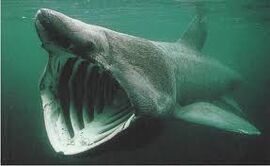
Basking Shark
The Basking Shark is the second largest living fish, after the whale shark. It is a cosmopolitan migratory species. It has long been a commercially important fish, as a source of food, shark fin, animal feed, and shark liver oil. Overexploitation has reduced its populations to the point that some have apparently disappeared and others need protection.
Description[]
The largest accurately-measured specimen was trapped in a herring net in the Bay of Fundy, Canada in 1851. Its total length was 12.27 meters (40.3 ft), and it weighed an estimated 19 tonnes (19 long tons; 21 short tons). Dubious reports from Norway mention three basking sharks over 12 meters (39 ft), the largest at 13.7 meters (45 ft), dubious because few anywhere near that size have been caught in the area since. On average, the adult basking shark reaches a length of 6–8 meters (20–26 ft) and weighs about 5.2 tonnes (5.1 long tons; 5.7 short tons). Some specimens still surpass 9–10 meters (30–33 ft), but after years of large-scale fishing, specimens of this size have become rare.
They possess the typical shark lamniform body plan and have been mistaken for great white sharks. The two species can be easily distinguished, however, by the basking shark's cavernous jaw, up to 1 meter (3 ft 3 in) in width, longer and more obvious gill slits that nearly encircle the head and are accompanied by well-developed gill rakers, smaller eyes, and smaller average girth. Great whites possess large, dagger-like teeth, basking shark teeth are much smaller 5–6 millimeters (0.20–0.24 in) and hooked; only the first three or four rows of the upper jaw and six or seven rows of the lower jaw function. In behavior, they also differ; the great white is an active predator of large animals and not a filter feeder.
Other distinctive characteristics include a strongly keeled caudal peduncle, highly textured skin covered in placoid scales and a mucus layer, a pointed snout—distinctly hooked in younger specimens—and a lunate caudal fin. In large individuals, the dorsal fin may flop to one side when above the surface. Coloration is highly variable (and likely dependent on observation conditions and the individual's condition): commonly, the colouring is dark brown to black or blue dorsally fading to a dull white ventrally. The sharks are often noticeably scarred, possibly through encounters with lampreys or cookiecutter sharks. The basking shark's liver, which may account for 25% of its body weight, runs the entire length of the abdominal cavity and is thought to play a role in buoyancy regulation and long-term energy storage.
Habitat[]
The basking shark is a coastal-pelagic shark found worldwide in boreal to warm-temperate waters around the continental shelves. It prefers 8 to 14.5 °C (46 to 58 °F) temperatures, but recently has been confirmed to cross the much-warmer waters at the equator. It is often seen close to land, including bays with narrow openings. The shark follows plankton concentrations in the water column and is therefore often visible at the surface. It characteristically migrates with the seasons. The basking shark is found from the surface down to at least 910 meters (2,990 ft).
Food[]
The basking shark is a passive feeder, filtering zooplankton, small fish and invertebrates from up to 2,000 short tons (1,800 t) of water per hour. They feed at or close to the surface with their mouths wide open and gill rakers erect.
